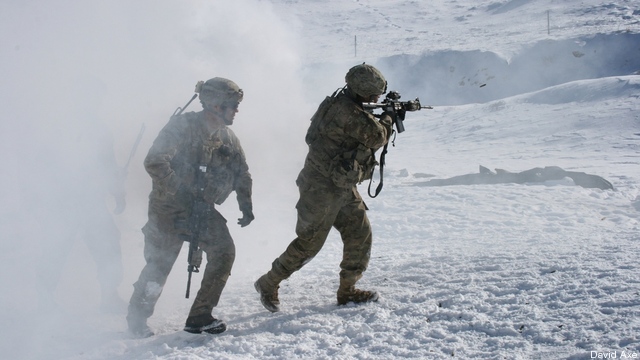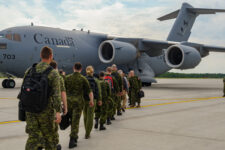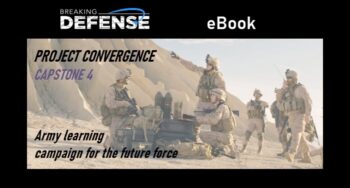 MARZAK, Afghanistan — In the middle of the night on July 23, U.S. Special Forces infiltrated a bowl-shaped valley in Paktika Province in remote eastern Afghanistan. Their target: a major Taliban encampment just outside this, which hadn’t had a government presence in decades. Taliban fighters had been using Marzak as a rest stop on the long road between Pakistan and Afghanistan’s major cities.
MARZAK, Afghanistan — In the middle of the night on July 23, U.S. Special Forces infiltrated a bowl-shaped valley in Paktika Province in remote eastern Afghanistan. Their target: a major Taliban encampment just outside this, which hadn’t had a government presence in decades. Taliban fighters had been using Marzak as a rest stop on the long road between Pakistan and Afghanistan’s major cities.
What followed was “one of the biggest fights of the year” in Afghanistan, according to U.S. Army Lt. Col. Curtis Taylor, commander of forces in western Paktika. When the sun rose on July 24, around 100 insurgents lay dead. One American had died.
July’s Operation Marauder Rapids was a classic counter-terrorism operation, featuring fine-grain intelligence, swiftly-moving Special Forces … and plenty of dead bad guys.
But what happened next read like a page from the Army’s counter-insurgency manual. Starting in November, regular Army troops and their allies in the Afghan army and police flew into Marzak, built a new patrol base, forged ties with local elders and began recruiting and training local police.
This interplay between counter-terrorism (CT) and classic counter-insurgency (COIN) operations lies at the heart of a new, more forceful U.S. approach to defeating insurgencies that’s taking hold in eastern Afghanistan in the waning years of the decade-old war.
The deaths of so many insurgents and their leaders outside Marzak had created a temporary vacuum — one the Taliban realistically would not be able to fill until spring, when the mountain passes open and fresh fighters can move in from Pakistan. “We need to do something permanent about this place before the Taliban comes back,” Taylor recalls thinking.
Today, the U.S. and Afghan military footprint in Marzak is steadily growing. Officers say the new government presence could result in a sea change in local attitudes and police capabilities, preventing another Taliban takeover even after most of the American soldiers depart this summer.
In Marzak, counter-terrorism operations cleared the way for counter-insurgency. If one influential retired Army general has his way, this “CT-as-COIN” strategy will become the new standard for the U.S. in eastern Afghanistan — and could point the way forward as the Army cuts 80,000 troops and reconfigures for the post-Iraq and -Afghanistan era.
Rumors of COIN’s Death
Listening to U.S. policymakers and defense analysts, it might seem counter-insurgency is already dead. With the Iraq war officially over (for the U.S.) and NATO forces drawing down in Afghanistan, the Pentagon is shifting its focus to global counter-terrorism and to the Pacific, where COIN is apparently useless and conventional naval and air power dominate.
But elements in the Army are determined to preserve, and even improve on, its hard-won COIN experience stretching back to the early days of the Iraq surge. The deadline for the withdrawal of U.S. combat troops from Afghanistan is only two years away, but in the country’s rugged east, the Army is still refining its methods for defeating insurgencies — and the Afghan insurgency, in particular.
CT-as-COIN is the latest twist. Its main champion is none other than retired Army Gen. Jack Keane, who in his unofficial advisory role helped Gen. David Petraeus sell the Iraq surge to Pres. George Bush in 2006. Keane has visited eastern Afghanistan at least twice in the past year, most recently in early January, meeting with officers to promote his concept.
In short, the new approach to COIN focuses first on killing insurgents, therefore removing what some consider the main obstacle preventing many Afghan communities from aligning with the government in Kabul. Old-style COIN works in the opposite direction, by attempting to win the consent of communities in the hope that the communities will eject insurgents on their own. In the old way of thinking, killing insurgents is almost an after-thought.
CT-as-COIN won’t work everywhere. It’s tailored for seasonal, rural insurgencies dominated by foreign fighters — in other words, Afghanistan, not Iraq.
In eastern Afghanistan, the hard-core insurgents are almost all foreigners: Pakistanis, Chechens, Arabs, etc. They are rarely welcome in Afghanistan’s widely spread communities and so tend to build encampments in the countryside — though close enough to settlements that they can exploit the villagers for food, supplies and guns-for-hire.
Most Afghans have little interest in fighting. That’s certainly the case in Marzak. But the tiny, isolated village had become a virtual pitstop for Taliban fighters on their way from Pakistan to Kabul and Kandahar.
In the absence of a government presence, the Taliban dominated. At the peak, no fewer than five separate Taliban bands were encamped around the village, according to Ish Khan, a cultural adviser to Taylor’s troops. The Talibs had banned dancing and forced some local men to fight alongside the hardcore insurgents. Two local men were killed in Operation Marauder Rapids.
In eastern Afghanistan, the insurgents are generally separate from civilians and out in the open. That means they can be aggressively targeted without major risk to innocent lives. In Operation Marauder Rapids, U.S. forces leveled heavy firepower on Marzak’s insurgents. U.S. troops in Paktika who have also fought in Iraq say artillery and air strikes are far more common in the former.
In all, regular troops and Special Forces in Taylor’s area of responsibility have killed or captured 17 insurgent leaders, plus hundreds of foot soldiers, in 19 major operations since August.
Those insurgents can be replaced. The Taliban and other insurgent groups can call on an essentially limitless source of new recruits in Pakistan and other foreign countries. “We’re not going to win a war of attrition,” Taylor tells Breaking Defense.
But fresh fighters can enter the war zone only during the spring and summer months, when the mountain passes are free of snow. U.S. troops are not nearly as constrained by winter; air transport and industrial-scale logistics mean the Americans operate year-round. Areas the Americans clear during winter months will remain clear until spring, giving the Americans temporary freedom of action — a key advantage.
Killing Your Way to Victory
In short, it’s just barely possible to kill your way to victory in Afghanistan, though Taylor is more guarded in his characterization. “Killing is necessary, but it’s a means to an end,” he says.
That end is aligning the population with the government. In Paktika, the major tool for bringing communities under Kabul’s umbrella is the new Afghan Local Police. The ALP program, launched last year, equips local volunteers with weapons, uniforms, basic training and monthly pay. The local cops fall under Ministry of Interior control but patrol only their home towns.
Taylor wanted to establish an ALP unit in Marzak. The deaths of 100 hardcore insurgents in Operation Marauder Rapids gave him the time and space to do so. “Most of the [insurgent] guys left in Paktika are low-level leaders or idiots,” says Maj. Eric Butler, Taylor’s intelligence chief.
“Because the leadership has been pushed out, we’ve been able to move in the ALP,” Taylor says. After an initial foray in November, in early January a strong coalition force — roughly a platoon each from the U.S. Army, Afghan army and Afghan police — established a rotating presence in Marzak. Their main goal: to train local police.
More than 50 local men promptly volunteered. The first platoon of roughly 40 local cops graduated from basic training on Jan. 23 and took up positions at an abandoned girls’ school converted into a patrol base. For the first time in memory, Marzak has a full-time government presence. U.S. troops plan on staying through the summer.
The eight months between Operation Marauder Rapids and the graduation of Marzak’s first local cops represent a dramatic proof-of-concept for Keane’s new, tougher CT-as-COIN approach to defeating insurgencies. With Keane’s advocacy, the concept could spread across eastern Afghanistan, potentially helping cement security gains ahead of the planned 2014 withdrawal of U.S. troops.
Plus, CT-as-COIN will remain in the Army’s intellectual arsenal even after U.S. pullout from Afghanistan. In an era in which traditional COIN seems increasingly discredited, the more lethal version might help preserve America’s ability to defeat insurgencies.
At least, certain kinds of insurgencies.
After shooting down Iranian munitions, Jordan defiant in uncomfortable spotlight
Amid Iranian criticism, “Jordanian leaders have been very clear to portray their action as defensive and in protection of their own sovereignty rather than any act in support of Israel, and this is sincere,” an analyst told Breaking Defense.


























